How do you follow a game that not only revitalized a franchise, but also restored many players’ faith in the power of the platformer? 2011’s Rayman Origins combined a refreshing and gorgeous aesthetic with smooth, interesting level design, and had some seriously questioning Mario’s place as the top of the genre.
Rayman Legends follows up in the most straightforward way it can: by stepping up its game in every possible aspect.
It certainly starts out feeling somewhat similar. Rayman, Globox and some other heroes set off to collect Lums and rescue Teensies through various levels. Some levels feature new mechanics, like projectiles and such, and every so often you’ll come across a boss battle or exciting chase sequence.
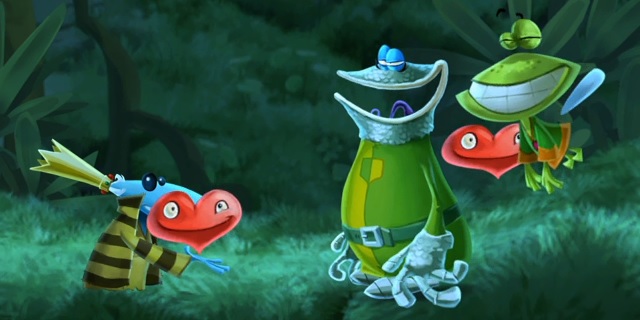
The controls themselves feel identical to Origins, and that’s definitely a good thing. Sometimes, you slip around a bit more than you’d like, but the inertia serves the speedier segments quite well. Those faster, precision-based levels make up a somewhat larger part of Legends this time, too; Ubisoft Montpelier seems to have noticed the popularity of those parts, and tried to expand upon them. The initial run through the campaign includes many exciting runs, but that’s only the start. New “invasion” events make you run through gauntlets to beat times and rescue Teensies, and the online Challenge Mode lets you chase new high scores every day.
Murfy out of his element
Playing solo? In Murfy-specific segments, you’ll be assisted by a computer-controlled companion. It’s not ideal, but some of the levels were designed to let you discover all the secret areas and items anyway by diverting its path in clever ways. On other platforms? Murfy’s actions are automated. It takes a bit of the fun away to just have his actions happen at the press of a button.
What’s really new about Legends is also the reason you should pick up the Wii U version if that’s an option for you. Murfy, Rayman’s frog-like companion, can be controlled using the GamePad’s touch screen to interact with various objects and enemies. These can be as simple as hitting switches, but often you’ll be tilting the GamePad to move on-screen objects or shielding your moving companions from fireballs. It’s more compelling than we expected, frankly; the feature seemed gimmicky at first, but there are some truly exhilarating (and yes, stressful) levels near the end of the game that test your dexterity and cooperation.
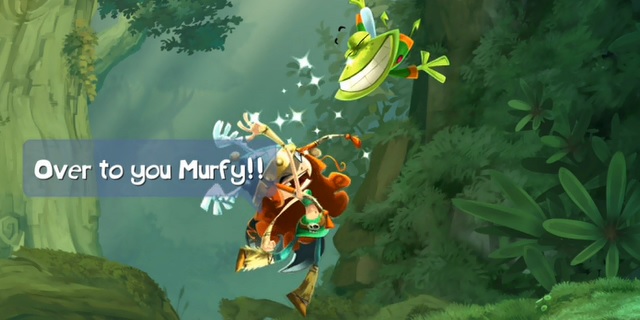
An expanding cast
Legends adds many more options to character selection. You get most of them by collecting more and more Lums, but each world also has two warrior princesses to unlock through completing specific, particularly challenging stages. These weapon-wielding heroes are functionally identical but super-fun to use, making a Rayman-free party less of a possibility and more of an inevitability.
Whether you’re looking at the GamePad or your TV, it’s hard to ignore just how beautiful Rayman Legends is. Adding in polygonal elements to the hand-drawn landscapes was a risky idea, but it’s pulled off well. Add to that the team’s second-generation ideas in the Ubi Art Framework, and it’s hitting all the right notes. Each world has its own separate theme. You’ll travel through castles with knights and dragons. You’ll perform some covert maneuvers through lasers and in underwater labyrinths. You’ll jump across and burrow through spicy food. Each of these worlds feels different, and it’s due, in large part, to nailing the aesthetic.
The soundtrack generally has a bit further to go to have that level of depth and variety, but it really kicks into gear in the more exciting levels and accomplishes its task in the slower ones. It’s certainly capable of nailing the theme, but it repeats a bit more often than you’d like.
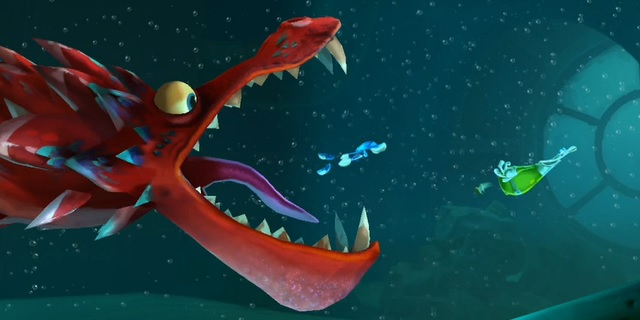
When you do play Rayman Legends (and you should), you should definitely bring a few friends along. The game is at its best when you’re taking levels on together, and it’s balanced in a way that really focuses on cooperation. Other “cooperative” games can get a bit more competitive and mean than really intended, but Legends has an “all-for-one” approach. You do keep separate Lum totals, but it’s more about making sure someone gets everything, so that player hanging back and collecting the 30 you would have missed is possibly more valuable than the one forging ahead in front and grabbing 200. The speed-based segments also benefit from the game’s “best ball” approach; only one needs to make it through a gauntlet, and working together can make it a bit easier.
When you are without friends around, though, it’s a good time to check out the game’s music-based stages. There’s only one in each world, which is a bit disappointing, since each is simply a blast. Having more than one runner and one Murfy can mess with your ability to get the timing just right, but both the tapping and the platforming experiences are pure joy. Not all of the song selections are quite as recognizable as the first world’s “Black Betty”-based “Castle Rock,” but they fit with the aesthetic of each area.
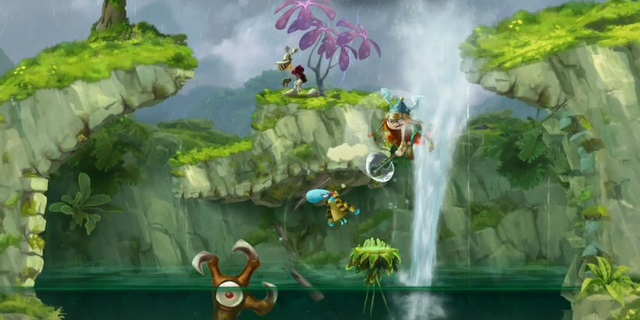
Who needs a story?
Narrative? Nah. Rayman Legends technically has you rescuing Teensies and chasing down the one responsible, but it couldn’t be less relevant. The game knows this and has fun with it, having the villain tricked and finished off in the same way over and over again.
Legends‘ delay was painful for many, but it allowed the team to add in 40 “Back to Origins” levels, reworked from the first game. With the new engine, Murfy’s help and the remixed level design, they don’t feel like an afterthought, and let’s be clear: 40 levels is a lot of content. It’s basically a second game. Included in these are some of the first game’s specialties, like the fun shooter stages.
You unlock these levels through a “Lucky Ticket” system. On each level, campaign or otherwise, you get a Lucky Ticket if you reach at least 75% of the Lums you’d need for a gold trophy. You then scratch them off (which is a bit silly) for various rewards, like extra Lums toward unlocking characters, extra Teensies toward unlocking levels and even Creatures, which let you farm Lums every day and are generally pointless. The reworked Origins stages are clearly the real prize, and it’s satisfying to get a new one.
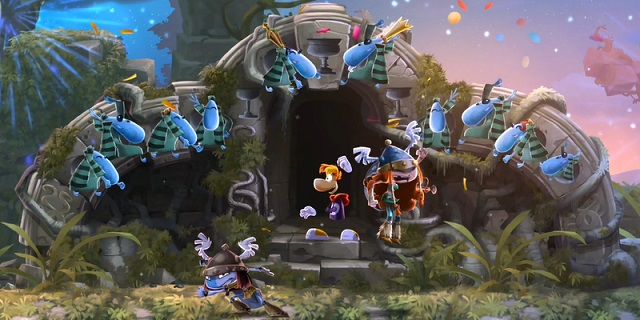
Rayman Legends is a treasure for those who love platforming, and the one to pick up if you only jump back in to the genre occasionally. It boasts a wealth of content to explore, and it’s designed to make you play every last bit and love every minute of it.
Pros: Lush visuals, varied level design, wealth of content
Cons: Occasional Murfy frustration, creatures are pointless



















